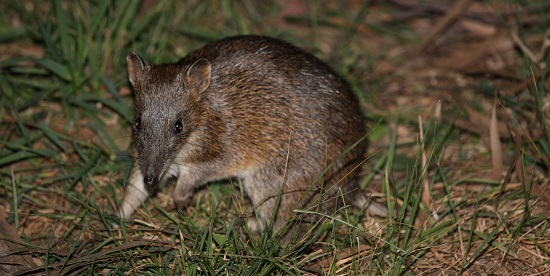Deakin research show bandicoots can thrive in Melbourne's outskirts
Media release
New research into the habits of the nationally endangered southern brown bandicoot has shown the marsupial to be a highly adaptable species capable of surviving and thriving in Melbourne's urban fringe.
The research team from Deakin University's Centre for Integrative Ecology in the School of Life and Environmental Sciences found the bandicoots will snack on pet food and other food left within their reach and, while they require thick plant cover for protection, will live just as happily in a blackberry bush as in native shrubbery.
The study, led by PhD researcher Sarah Maclagan, used radio transmitters to track 56 bandicoots over 17 months in the former Kooweerup swamp region, between Cranbourne, Bunyip and Western Port Bay, where the bandicoot population persists within narrow strips of vegetation along drains, roads and railways in an otherwise cleared landscape.
Ms Maclagan said the aim was to better understand how bandicoots were surviving in this human-dominated landscape to increase the chances of conserving them as urbanisation continues.
"Specifically, we were interested in whether bandicoots stayed in corridors of remnant native vegetation, which is their preferred habitat, or whether they ventured out into the broader more urbanised landscape," Ms Maclagan said.
"We found bandicoots are highly adaptable, being able to survive quite well in narrow strips of dense vegetation, even as little as 16.5m wide," Ms Maclagan said.
"The majority of adult males (71%) moved out into surrounding farms and residential properties and had longer home ranges than the females. By contrast, only a third of females and none of the juveniles strayed from the cover of thick, remnant vegetation.
"We think that's because males have a larger body size so are less susceptible to predators, which allows them to forage more widely for food and to find a mate," Ms Maclagan said.
Associate Professor Euan Ritchie said while the southern brown bandicoot was once found widely across south-eastern Australia, its population had declined due to habitat loss and introduced predators, such as foxes, cats and dogs. Bandicoots are also likely to be mistaken for rats and poisoned.
"This study gives us reason to be optimistic about the bandicoot's ability to survive the growth of urbanisation," Associate Professor Ritchie said.
"We found them turning up in people's backyards when it was feeding time for domestic animals such as chickens, pigs and rabbits so they're actually very clever at taking advantage of human provided food, although we're not yet sure what the health effects of that might be.
"But the important thing is maintaining those dense strips of vegetation that bandicoots need to nest and breed, and making sure they're as connected as possible for bandicoots to live in and move through."
The research, titled Life in Linear Habitats: the Movement Ecology of an Endangered Mammal in a Peri-urban Landscape has been published in Animal Conservation and is available here.

